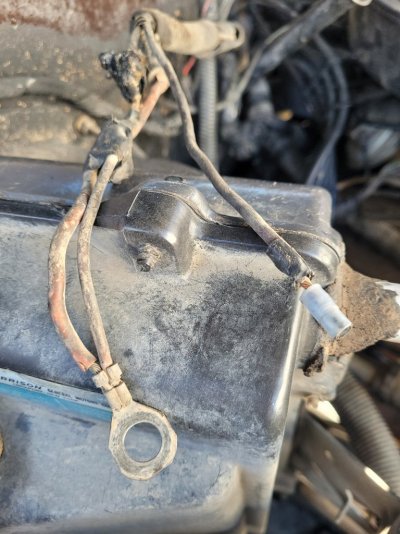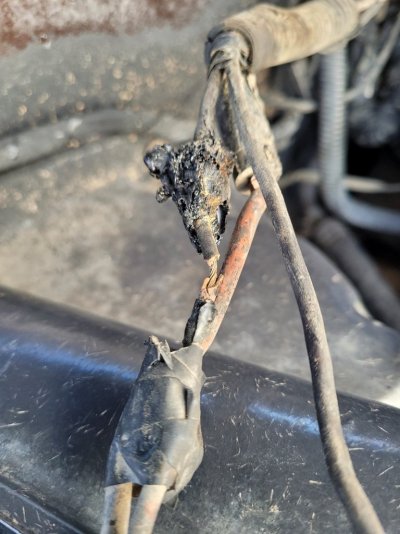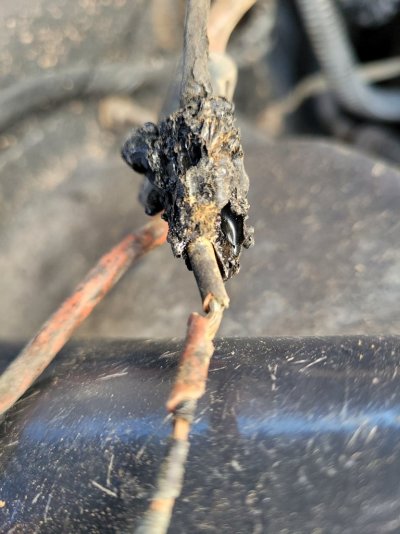I am probably late to the party, but I might have some helpful insight. This sounds VERY close to what happened to my 85 Silverado. In my case, it kept killing batteries. Not outright killing them... everything would seem fine for a while, then out of the blue, the battery would not have the gumption to turn over the engine. Mine is a pieced and patched together son-of-a-mechanic special that a girlfriend/ex/whatever picked up for $500 a decade before we met, and her prack ex husband allowed NO money to be invested in the truck (read as: no oil changes, tune ups, new hoses, NOTHING). As you can guess, she needed some serious TLC. So much so, that when I started working on her and the list of issues grew, were diagnosed, and addressed, she eventually became mine just on sheer time and parts costs invested (they eventually added up to way more than she had paid for the vehicle). But I digress. This truck went from rough to running like a top, I mean the 350 runs smoother than "modern" ones less than five years old. So it puzzled me as to why she was eating batteries. She had the same intermittent glitches and issues you describe, up to and including the voltage "sag" at random times, including when hitting the brake pedal. Then one fine night in Reno, NV, about an hour from my northern California mountain town home, leaving a 24-hour grocery store at around one in the morning, she failed to start. I mean nothing... no click, no clatter, no whine, grind, fuel pump sound, nothing. No lights, either, including dash lights. Nada. It was 18 degrees out in mid-October. Cold, but should not have killed what was a pretty strong battery in under an hour. A kind lady passing by noticed my hood up, stopped and offered a jump start, and she fired right up. After sitting in the parking lot a good 30 minutes running the engine a good bit above idle to give the battery a chance to build up some juice, I dropped her in gear and headed home. No sooner were we on the highway and up to speed, I knew I was in trouble. Something felt "off", and within moments the headlights seemed dimmer, and throttle response was "mushy". We had the heater running, and the headlights were on, but no other draws on the electrical system... which sagged noticeably when I applied the brakes.
That was a damn near terrifying drive home. There was no "moonlit night" driving to save me... which was painfully obvious as the lights grew more and more dim, the road harder to see... we slowed to roll through he inspection station at the state line, and accelerating to return to highway speed was when it happened. I thought my engine was going to explode. She began to lurch and buck, emitting a series of ear splitting pops and bangs that sounded like someone had lit off a metal lunch box full of M-80 firecrackers in an empty bus station dumpster, the headlights and running lights cut out entirely, then back on, then off, strobing on and off randomly as the engine misfired over and over and I lost all throttle response and the truck slowed to a crawl. I steered sharply towards the berm, intentionally planting my driver side wheels squarely on the "wake up you idiot" divets just inside the edge line, manually shifted down through the gears while feathering the gas pedal, cutting off the heater blower entirely as I did so. She sputtered for what seemed an eternity, then slowly smoothed out as the divets rattled my teeth nearly out of my skull, and gradually picked up speed until I could merge back into the highway and accelerate to normal speed. With thirty miles yet to get home, I could only operate the headlights on low beam or the problem began again.
It was a long, cold, white knuckled drive home, as the low beams dwindled and disappeared within five minutes of the inspection station incident. NO accessories could be used. I figured at this point that it could only be an alternator issue. This early guess was supported by the fact that when I arrived by some miracle in my driveway after having driven 47 miles at highway speed on a moonless night with no headlights, dash or running lights, when I shut off the engine and attempted to start it again, I got only dead silence.
I enlisted my girlfriend's aid the next morning to try jump starting the truck with a booster pack. I am not sure if she goofed and put the cables on the terminals in reverse order or not (she swears she didn't) but the shower of sparks was both visible and audible in spite of my being in the cab with the hood up.
Thus began my adventure into automotive wiring. I dove in head first, absorbing information like a sponge, spending hours and hours reading forums and skulling out wiring diagrams. Here is what I can tell you, and it may help you solve your problem.
Old trucks of our era came with stock incandescent headlights. Halogen bulbs emerged somewhere around that time, and the logical thing to do is upgrade, right? Especially when there are drop in replacements readily available nowadays. I bet your truck, like mine, has had halogen replacements installed. The amperage required to light those brighter lights is WAY higher than the stock amperage normally sent to the headlights. Hang on to that tidbit.
I believe I saw in your sig that you come from a four seasons climate, as do I. A heater blower motor, or an AC system, for that matter, draws a hefty amount of current when operated. Hang on to that, too.
A stock radio doesn't draw much, but if you have an aftermarket stereo with multiple disc changer, power amp, or any other such bells and whistles, those things draw more than the allotted stock amount of juice when operated.
Cell phone charger plugged into the cigarette lighter? More current required.
GPS unit, CB radio, Sirius XM radio, anything like that? More current required.
Now add up the sum total of all those tidbits I told you to hang on to from above... for most folks, that adds up to a lot of tidbits.
Each of those has an amperage draw. Some are smaller, say 3 go 5 amps, and others are whopping big...blower motors for heat and/or AC can run a minimum of 15 amps, with 30 being pretty common.
Now... trucks like ours came equipped with a stock run-of-the-mill AC Delco alternator, which is not a bad alternator at all, but running at about 3,000 rps, those units crank out a whopping 30-40 amps of juice, which gets divided between charging the battery, powering accessories you have turned on at any given time, and PROVIDING THE ELECTRICITY TO OPERATE ALL YOUR VEHICLE'S SYSTEMS... starting with the current that goes to your spark plugs to make your engine run at all, to any non-mechanically driven (not driven by your crankshaft) components that take care of fuel delivery, power steering, and the like. Part of that available juice goes to things like the feedback wire between your amp/volt meter in your dash and one of the terminals on the back of your alternator, commonly called the "exciter" wire because it tells the alternator when it needs to turn on to generate electricity. It should be brown in color, by the way.
What this has to do with the price of tea in China... is that if your tidbit list adds up to, say, 43 amperes demanded of your truck's system, and your alternator is the vintage variety that puts out, to pick a number, 37 amps of current, than means that you are running at a defecit of 6 amperes of juice IF you are averaging 3,000 rpms. I doubt your wife or you are driving in that rpm range on dirt or country roads very often. That is more like highway speeds in my book. Now consider that at roughtly 1,000 rps or a bit higher, about idle speed, you alternator if very likely producing NO electricity at all, as it hasn't passed the threshold rpms that tell the exciter wire to kick the alternator in the backside and start making and sending that electricity to the battery. So your battery is gradually being depleted of its juice at every stop sign, stop light, construction zone, rubbernecker accident slowdown, or other reason you cut your rpms drastically for any length of time while still having all your tidbits up and running.
I know, I know, you may already know about this. But what many folks do NOT know, and I was one of them, is that simple little things cause bigger, more complex problems. To save boring you to tears, my overly analytical, overthinking mind went over every possible angle of how and why this could get out of control so fast, and I came up with the following:
1)Start at your battery. Have it load tested at a reputable auto parts store (usually for free). It can show 12+ volts of electricity all day long and not start your truck if it lacks the amps to turn it over...as in it cannot provide enough power at once, for long enough, to overcome the resistance of the engine's pistons compressing the fuel in the cylinders).
2) Next check your battery cables. NOT just the terminal (but yes, those, too). All surfaces should be clean, shiny, and bright where the "jaw" of the cable's terminal grabs and holds onto the post of the battery terminal itself. Notice that the + or positive terminal is NOT the same diameter thickness as the - or negative terminal of the battery. A prior owner of my truck must have been tight for cash and used a + terminal from a spare cable in place of a worn - cable terminal on my truck's battery, because my cable terminals were the same size... which meant my - or negative terminal cable was ALWAYS LOOSE on the battery's negative terminal, even when cranked down tightly. Road vibration loosens those up FAST if they are not the correct size! If all else fails, use a pair of micrometers to measure the exact battery post size, or use a piece of paper and pencil to do a "gravestone rubbing" of the top of the post, and take it with you if you need to replace a terminal. Why is this so important? On to the next item on the list...
3)Check the battery cables themselves. Use a pen knife or sharp pair of bandage scissors (don't admit to using your wife's, she will kill you for it) to very carefully make a straight cut through the colored rubber/plastic jacket of the cable, the direction of the cable (not in a circle around the cable), for both your positive and your negative battery cables that leave the battery and head towards the engine (the big, thick ones, and they should be about the thickness of at least your pinky finger). Start with a small cut, maybe a quarter inch or so, and carefully look between the jacket and copper stranded monster hunk of cable. If there is any powdery white, greenish white, or other dull colored "crud" on the wire, continue the cut a quarter inch or so at a time until you arrive at clean, bright copper wire again. Provided you haven't travelled half the cable doing this, you may cut off the corroded section, reattach the clean cable end to the clean terminal, and reattach the terminal to the battery post. As you may discover, the cables can LOOK perfectly clean and fine on the outside, and hide an ugly amount of corrosion on the inside of the cable jacket. I have seen them look fine and dandy on the outside, and when checked, be HOLLOW for the first quarter inch on the inside except for three or four strands of wire still attached! No kidding... this is very simple but can wreak havoc on your truck's performance. If you do not have a good ground for your electrical system, no matter HOW much juice your alternator supplies your battery, it will never GET THERE, and your battery will slowly deplete and your performance will suffer.
4)Next point... you should also check for corrosion in your other wires leaving your battery... a smaller, usually red jacketed wire that leaves your battery from the positive terminal, and runs down towards the engine block, leads to your starter solenoid, which is a switch that helps turn your starter on and off. It should be clean, bright and shiny on the contact surfaces at the battery, and quite tight, and usually has a rubber boot over it where it ends on the solenoid, and MUST be very tight there. Also check the similarly sized, usually black jacketed wire from your battery negative terminal that leaves and usually attaches to your frame by being bolted down next to your radiator up top. All surfaces clean and bright as always. The other important one, easier to check if your truck is up on a lift, is to find your strap grounds. These look like flat braided metal straps, about half an inch wide or so, and there should be two of them, one on each side of your engine block, that connect from the engine block to the firewall (the inside wall of the engine cavity that separates it from the cab of the truck).
Provided ALL of the above have a clean bill of health and your problem does not disappear, you may need to consider a couple options. One is to put your headlights (especially if modernized headlights such as halogen lights or other high output bulbs have been installed) onto a separate relay. This simply means separating the headlight wiring from the main harness so that its electrical supply is fed separately from the other items typically "bundled" in the same wiring group and routed to the cab. This basically puts less of a demand on the "general" electrical supply by not making the lights "share" the same "lane" to receive their supply. Likewise with more involved stereo systems or other high-demand add-on items. If you have a good amount of extras, you might even want to consider adding an extra battery on its own circuit and wiring your extras directly to that to ease the load on your system in general.
Last but not least, you might consider upgrading your alternator to a higher output one, making sure that you choose a model whose specifications are compatible with your specific engine and its demands. Mine cost me about $130 through Summit Racing, but it puts out 150 or more amps of power at cruising speeds, and even charges my battery while I am idling the engine at stoplights! I went a step further and installed an extra fuse box under my hood to handle my stereo system, trailer brakes and electrical package, off road lighting bars, pickup bed 12v DC beer cooler movie screen, etc.
All the old problems are gone, and to boot, my truck runs much stronger, smoother, and quieter than before... to the envy of more than one previous owner.
Little fixes, big results.
Best of luck, and let me know if this helped at all.
T




